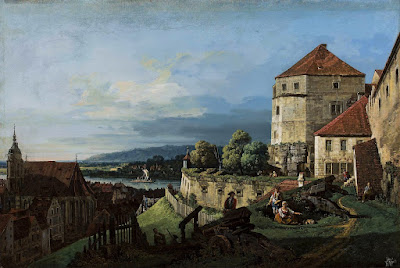 |
| Bernardo Bellotto Upper Reaches of Grand Canal facing Santa Croce, Venice ca. 1740-50 oil on canvas National Gallery, London |
 |
| Bernardo Bellotto Upper Reaches of Grand Canal facing Santa Croce (detail) ca. 1740-50 oil on canvas National Gallery, London |
 |
| Bernardo Bellotto Entrance to Grand Canal, with Santa Maria della Salute, Venice ca. 1740-50 oil on canvas Musée du Louvre |
 |
| Bernardo Bellotto Entrance to Grand Canal, with Santa Maria della Salute (detail) ca. 1740-50 oil on canvas Musée du Louvre |
 |
| Bernardo Bellotto Piazza di San Giovanni in Laterano, Rome 1744 oil on canvas private collection |
 |
| Bernardo Bellotto Piazza della Signoria, Florence 1742 oil on canvas Museum of Fine Arts, Budapest |
 |
| Bernardo Bellotto Piazza San Martino, Lucca before 1750 oil on canvas York City Art Gallery |
 |
| Bernardo Bellotto Ruins of Devín Castle, Bratislava ca. 1759-60 oil on canvas Kunsthistorisches Museum, Vienna |
 |
| Bernardo Bellotto View of Prina from Sonnenstein Castle ca. 1759-60 oil on canvas Musée du Louvre |
 |
| Bernardo Bellotto View of Prina with the Fortress of Sonnenstein ca. 1755-65 oil on canvas Art Institute of Chicago |
 |
| Bernardo Bellotto View of Schloss Hof, Austria ca. 1759-60 oil on canvas Kunsthistorisches Museum, Vienna |
 |
| Bernardo Bellotto View of Schloss Hof, Austria ca. 1759-60 oil on canvas Kunsthistorisches Museum, Vienna |
 |
| Bernardo Bellotto Miodowa Street, Warsaw 1777 oil on canvas Royal Castle, Warsaw |
 |
| Bernardo Bellotto Bridgettine Church and Arsenal, Warsaw 1780 oil on canvas Royal Castle, Warsaw |
 |
| Bernardo Bellotto Lobkowitzplatz, Vienna ca. 1759-60 oil on canvas Kunsthistorisches Museum, Vienna |
"Born in Venice in 1722, Bellotto had a precocious talent. He received his earliest training with his uncle, the celebrated view painter Canaletto, from about 1735 onwards, and was accepted into the Fraglia dei Pittori (Venetian painters' guild) at the age of just 16. In the 1740s Bellotto traveled extensively around the Italian peninsula, producing views of various cities including Florence, Rome, Verona and Turin. He was called to Dresden in 1747, and the subsequent year was appointed Court Painter to Augustus III, King of Poland and Elector of Saxony. Following the escalation of the Seven Years' War around 1758, Bellotto worked at the courts of Vienna (ca. 1758/59-1761) and Munich (1761), before returning again to Dresden (1761-66). He spent the last 13 years of his life in Warsaw, at the court of Augustus III's successor, Stanislaus II August Poniatowski."
"Bellotto tends towards a more silvery light than Canaletto, as well as a cooler palette and a greater sense of monumentality. Even when one of his compositions derived from a painting by his uncle, Bellotto tended to increase it in both size and scale. . . . Today, Bellotto is best known for his views of northern European cities, characterised by panoramic compositions, strongly contrasted use of light and shadow, and meticulous attention to architectural detail. Such was Bellotto's precision that his late views of Warsaw played a crucial role in that city's reconstruction after the Second World War."
– from curator's notes at the National Gallery, London